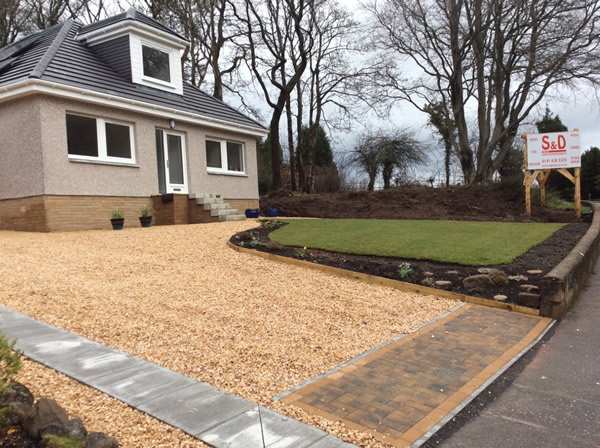- Glasgow South 0141 638 3335
- Glasgow North 0141 942 5596
- EMAIL US
What’s a Green Driveway?
The hard landscaping outside of a property is important. It creates the overall impression of your home but it also contributes to what happens to rainwater on your property. With localised flooding becoming more of an issue, there is no better time to invest in a green driveway. But what is a green driveway? What are the pros and cons?
A green driveway – a permeable alternative
Localised flooding after a downpour or prolonged rain happens because the drains and sewers can’t cope with the volume of water.
If your driveway was ‘green’ or permeable, some of this water would soak away to the ground beneath, placing less of a strain on the storm drains but also helping the local water table too.
What it doesn’t mean is a grass driveway, although that is an option. But if a green driveway suitable for every property?
A permeable driveway – the options
There are many green driveway options;
- Loose gravel and chippings – when laid correctly, a gravel driveway is a superb green driveway, allowing rainwater to soak through. However, it is unsuitable for driveways on an incline as the gravel will wash away or into a big heap and it will need maintenance too.
- Grassed driveway – many people assume this is allowing a strip of bare earth to grass over and nothing more. As vehicles are driven over it or parked on it, undulations appear and that means muddy puddles. Likewise, as the earth compacts, it becomes difficult for rainwater to efficiently drain away. A grassed driveway takes a little more preparation in terms of foundations but is certainly a worthwhile option to consider.
- Permeable materials – the range of permeable materials for use in hard landscaping is increasing. Resin driveways can be permeable as too can concrete driveways but they can be more expensive in terms of materials than an ‘ordinary’ concrete driveway, for example. They are proving popular choices and with many local councils now insisting on permeable driveway materials for new builds, the expanse of such materials looks set to increase.
Laying a green driveway
Many clients have opted for a grassed driveway but it's important to understand the need for adequate preparation of the sub-soil sections.
In most cases, using plastic ‘crates’ to form a firm surface is the way forward, with tough grass growing in between the cutout portions of each crate. As well as grass, hardy alpine type plants can also be used, including sedum and other plants commonly used in green roofs.
Worth the ‘extra’ hassle?
Laying a green driveway, whether that is a grassed driveway or a permeable one, is not ore ‘fussy’ than laying any other kind of driveway. It can add value to your property too, with potential buyers just as keen as you to ensure that everything about the property is sustainable and eco-friendly.
And it will help with stormwater management too, helping to control the movement of water on your property. And that can only be a good thing.

